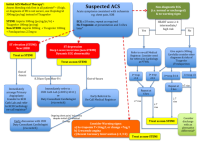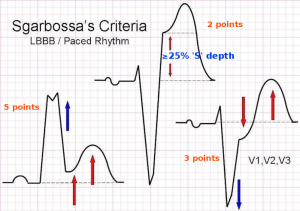Table of Contents
Cardiac Ischaemia
- Non-ischaemic ST elevation is seen in 15% population, especially young men
- abnormal ST elevation:
- Leads V2,3 >0.2mV in men >40y and >0.25mV in men <40y (>0.1mV in all other leads)
- Leads V2,3 >0.15mV in women (>0.1mV in all other leads)
- usually convex or straight
STEMI
- ST elevation reflects transmural ischaemia
- criteria for STEMI in patients with LBBB = modified Sgarbossa criteria (≥3 points 90% specificity for STEMI)
- 5 points: ≥1 lead with ST elevation ≥1mm, concordant with the vector of the QRS complex
- 3 points: ≥1 lead of V1-V3 concordant ST depression ≥1 mm
- 2 points: ≥1 lead with discordant ST elevation ≥25% of depth of preceding S wave (Leads V1-3)
NSTEMI
- patients determined to have symptoms consistent with ACS and troponin elevation but without ECG changes consistent with STEMI
- may have transient ST elevation, ST depression, or new T wave inversion
- differs from Unstable angina in that cardiac markers are elevated
- *de Winter T waves are associated with LAD occlusion and sometimes considered STEMI equivalent
MINOCA (MI with non obstructive coronary arteries)
- not a benign diagnosis: outcomes similar to those of patients with acute MI and obstructive coronary disease up to 1 year
Acute Coronary Syndrome
| New York functional classification of angina: in patients with cardiac disease |
|
| Class I | • no limitation of physical activity |
|---|---|
| Class II | • slight limitation of physical activity • comfortable at rest but ordinary activity causes symptoms |
| Class III | • marked limitation of physical activity • comfortable at rest but less than ordinary activity causes symptoms |
| Class IV | • inability to carry on any physical activity without discomfort • may have symptoms at rest |
Spontaneous Coronary Artery Dissection (SCAD)
- SCAD may be a cause of up to 1% to 4% of ACS cases overall
- occurs overwhelmingly in women and may be the cause of ACS in up to 35% of MIs in women ≤50 years of age
- most common cause of pregnancy-associated MI (43%)
Non-ischaemic ST elevation
usually concave pattern
- associated with LVH
- secondary to conduction defect eg LBBB, non-specific intracardiac conduction delay, WPW
- Early repolarization pattern
- Spontaneously reperfused STEMI
- Aneurysm/old myocardial infarction
- Pericarditis/myocarditis
- Brugada pattern
- Takotsubo (apical ballooning) syndrome, AKA 'broken heart syndrome'
- Hyperkalaemia, Hypercalcaemia
Early repolarisation
- especially young, athletic afro-Caribbean males and Hispanics
- often disappears with hyperventilation & tachycardia
- usually early V leads
MI localisation ECG patterns
The different infarct patterns are named according to the leads with maximal ST elevation:
- Septal = V1-2
- Anterior = V2-5
- Anteroseptal = V1-4
Atrial ischaemia/infarction
Liu’s criteria for diagnosing atrial ischaemia / infarction include:
- Major criteria
- PR elevation >0.5 mm in V5 & V6 with reciprocal PR depression in V1 & V2
- PR elevation >0.5 mm in lead I with reciprocal PR depression in leads II & III
- PR depression >1.5 mm in the precordial leads
- PR depression >1.2 mm in leads I, II, & III
- Minor criteria:
- Abnormal P wave morphology: eg M-shaped, W-shaped, irregular or notched
Posterior MI
- ST depression (not elevation) in the septal & anterior precordial leads (V1-V4)*. This occurs because these ECG leads will see the MI backwards; the leads are placed anteriorly, but the myocardial injury is posterior.
- A R/S wave ratio greater than 1 in leads V1 or V2.
- ST elevation in the posterior leads of a posterior ECG (leads V7-V9). Suspicion for a posterior MI must remain high, especially if inferior ST segment elevation is also present.
- ST elevation in the inferior leads (II, III and aVF) if an inferior MI is also present.
HEART score
HEART score | ||
| History | • Highly suspicious • Moderately suspicious • Slightly suspicious | 2 1 0 |
| ECG | • Significant ST depression • Non-specific repolarisation change/LBBB/PM Normal | 2 1 0 |
| Age | • ≥65 • 45-65 • <45 | 2 1 0 |
| Risk factors | • Hx of atherosclerosis or ≥3 risk factors eg ↑chol, diabetes, smoker, +ve FHx, BMI>30, PHx-MI,PCI,CABG,CVA,TIA,PVD • 1-2 risk factors no risk factors | 2 1 0 |
| Troponin | • ≥3x normal • 1-3x normal limit • normal | 2 1 0 |
SYNTAX score
- a scoring system used to determine intervention strategies - PCI vs CABG
- The SYNTAX score is the sum of the points assigned to each individual lesion identified in the coronary tree with >50% diameter narrowing in vessels >1.5mm diameter.
- The coronary tree is divided into 16 segments according to AHA classification, with scores of 1 or 2 attributed to each relevant lesion and then weighted for calculation.
- Higher scores represent greater risk for PCI and therefore more indicative of need for CABG
https://www.cathlabdigest.com/articles/What-SYNTAX-Score-and-How-Should-We-Use-It
References include:
St elevation - ischaemia vs non-ischaemia 2014
Takotsubo cardiomyopathy
https://the-breach.com/introducing-the-modified-sgarbossa-criteria/
https://epmonthly.com/article/stemi-in-the-presence-of-lbbb/
NSTEMI 2020
global T inversion review
4th universal definition of Myocardial infarction 2018
Circulation: Localisation of MI's - New terminology 2006





